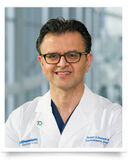Surgeon Q&A: What Are My Heart Valve Replacement Options? (Plus, 3 Patient Stories)
Written By: Adam Pick, Patient Advocate, Author & Website Founder
Medical Expert: Alfredo Trento, MD, Cedars-Sinai
Page Last Updated: May 6, 2025
A common question I receive from patients who can not have their valves repaired is, “What are my valve heart replacement options?”
For this reason… I jumped at the chance to film an educational video about this topic with Dr. Alfredo Trento, the Director of Cardio-Thoracic Surgery at Cedars-Sinai Medical Center. So you know, Dr. Trento is a valve guru having successfully performed over 4,000 heart valve operations and treated many patients from our community including Robin Hirsch, Jerry Andis and Angie Brooks. 🙂
Here are the highlights from my discussion with Dr. Trento…
As many patients, including me, will tell you… The process of selecting a heart valve replacement can be challenging. I always encourage patients and their family members to create a “Pros and Cons” list for each valve given the patient’s lifestyle, age and activity level. As one doctor confided in me, “At this time, there really is not a perfect valve replacement for all patients types. There are, however, many options that have been developed to fit each patient population.”
Patient Success Story Videos with Mechanical, Tissue & TAVR Valves
For this reason, I these and other reasons, I thought you might like to see patient success stories I filmed with patients that selected different types of valve including a mechanical valve, a tissue valve and a TAVR.
First up… Here’s the success story of Fred Holberg, the coach of the Chicago Bulls, who selected an aortic mechanical valve replacement due to its durability.
Next, is the story of Clarissa Alaimo who had a mitral valve replacement and Maze Procedure due to stenosis and atrial fibrillation.
And… Here is the story of Jon Gerlits who received a transcather aortic valve replacement for aortic stenosis.
I hope this helped you learn more about heart valve replacement options for patients. I want to extend a huge thanks to Dr. Trento for taking the time to share his clinical experience and research with our patient community. Also, a special thanks goes out to Gordon Kolodny, Thomas DeSanto and the entire team at Cedars-Sinai for providing this very special opportunity.
- See Dr. Trento’s Video About Robotic Mitral Valve Surgery
- Visit the Cedars-Sinai Heart Valve Microsite
Keep on tickin!
Adam
P.S. Here is a written transcript of my interview with Dr. Trento:
My name is Alfredo Trento. I am Director of the division of cardiothoracic surgery at Cedars-Sinai Medical Center. My career started in the early ’80s. For the past 20 years, I have performed a lot of mitral and aortic valve surgery, also tricuspid valve surgery, either repair or replacement. I would say that my clinical activity is focused for about 80% into valve surgery right now.

The indications for heart valve surgeries are obviously different from aortic valve and mitral valve. The most frequent indication for aortic valve surgery is aortic stenosis. For aortic valve surgery, we have to replace the valve when the valve is stenotic and narrow. The valve becomes very calcified and doesn’t open up anymore. There is no medical therapy for this condition and we just have to replace this valve.
For the mitral valve, the most frequent indication for mitral valve surgery is mitral regurgitation. The valve is leaking a lot. We can repair that valve, with a high incidence of success. Over 90% success, if the surgery is performed by competent surgeons. There are some situations in which the valve is leaking but a repair is not possible. Very often, this is in patients where prior heart attack.
What are the different types of heart valve replacements?
There are two general types of valve prosthesis, or artificial valves. One is a mechanical valve. Mechanical valve means that it’s completely manmade; there is no biologic tissue in the valve. This is a mechanical valve. It’s called a bileaflet valve. There are two little leaflet here and they open and closed. Then you see this cuff, which is a fabric called Dacron. This is the cuff where the stitches go in and anchor the valve where we want to position. This can be an aortic valve or can be a mitral valve.
The issue with this valve – as you see is all artificial – is that when this valve is in the blood flow, the blood will tend to make little blood clots around all the entry points of the valve. For this reason, the patients who have a valve like this need to take a pretty significant blood thinner called Coumadin or the like. Coumadin requires a very careful follow up with the doctors and blood tests, to make sure the amount of Coumadin is the appropriate amount.
The other type of valve that we have is called a biological valve, or a tissue valve. It’s called in this way because a portion of the valve comes from an animal. The animal can be either a pig or a cow. This is a typical example of a biological valve. You see the internal part of the valve, you see there is still a cuff of fabric called Dacron, but inside portion comes directly from a pig valve. This is a pig valve. This valve is a much more user-friendly in the sense that you need to take a blood thinner only for a certain period of time. The downside of the valve is that it doesn’t last as long as the mechanical valve. The durability of the valve is very much related to the patient’s age.
The durability is very much related to the age of the patient. If you are over aged 70, this valve will last 15, 20 years. If you are younger than 60, it would probably last 10 years. These are the considerations that we have to make when we decide what kind of valve a patient wants. Obviously the patient has a lot to say about the type of valve he wants. This is really very much individual choice.
This is a cow valve here. This doesn’t come from the valve of a cow, but the tissue that they use is around the heart, called pericardium. This is called a bovine pericardium valve. For aortic valve, this has become the valve of choice, the bovine pericardium valve.
How are heart valve sized for the patients?
We have obviously different sizes. This is a valve sizer. What we do, first we remove the diseased valve, and then we use this sizer to size the opening of the valve so we can choose the appropriate size valve. We have different size valves in the shelves. The valve can be small, like in this one, or can be double size, depending on the size of the opening.
How have heart valve replacements advanced during the past 20 years?
Valve technology has improved significantly, and the valves have become more efficient. To give you an idea, you see how much bigger this valve is than this valve. Obviously this valve is smaller. The cuff around it in this valve is much smaller and opening in relation to the diameter of the valve is quite nice. A lot of progress has been made through the years in this aspect.
There are new valves now that are called sutureless valves. The first sutureless valve has just been approved by the FDA for use in this country. It’s put in, just like with a system similar to this in shape, and then deployed right where the opening of the valve is. In theory, this is a much faster procedure. Finally, the other improvement is that the overall procedure has become so standardized. I have done three hundred aortic valve replacements without losing a patient, so it has become quite safe.
The transcatheter aortic valve replacement (TAVR) devices, it’s definitely one of the great achievement of cardiac valve technology. The valve is put at the tip of this catheter and then it’s passed through artery in the leg backwards, up around the aorta and down where the opening of the valve is.
The patient’s valve is not removed. The patient’s valve is left there, and the new valve is deployed inside the old valve. This has been used very much in patients who cannot have open heart surgery for some physical conditions that makes the surgery very risky. The results are quite good for that type of patient.
What is Dr. Trento’s best piece of advice for patients needing a heart valve replacement?
When a patient has been told by his Cardiologist that he needs a valve replacement, the most important thing that the patient has to decide is where can I have this procedure done safely? He should go to a center where a certain critical number of these procedures is performed every year. I think that there is a difference in the outcome. If you go to a place where they do ten valve replacement a year versus a place where they do 200 valve replacements every year, I think that there is a certain difference in the outcome.
|
Terry says on July 22nd, 2016 at 7:18 am |
|
So… I had a bovine pericardial valve/Bentall procedure 2 years ago at 54 years of age. If/when this valve wears out, would TAVR be an option for me? I’m not exactly enthusiastic about having open-heart surgery again… |
 |
|
Tanja Lynn Hamilton Duffey says on July 28th, 2016 at 9:38 am |
|
I am going to have a CorMatrix ECM Tricuspid Valve placed on August 1st at the Mayo Clinic. I am part of a clinical trial that is researching a material that will literally allow me to grow a new tricuspid valve. I think it is so exciting to be a part of this research. The future applications will be amazing. |
 |











